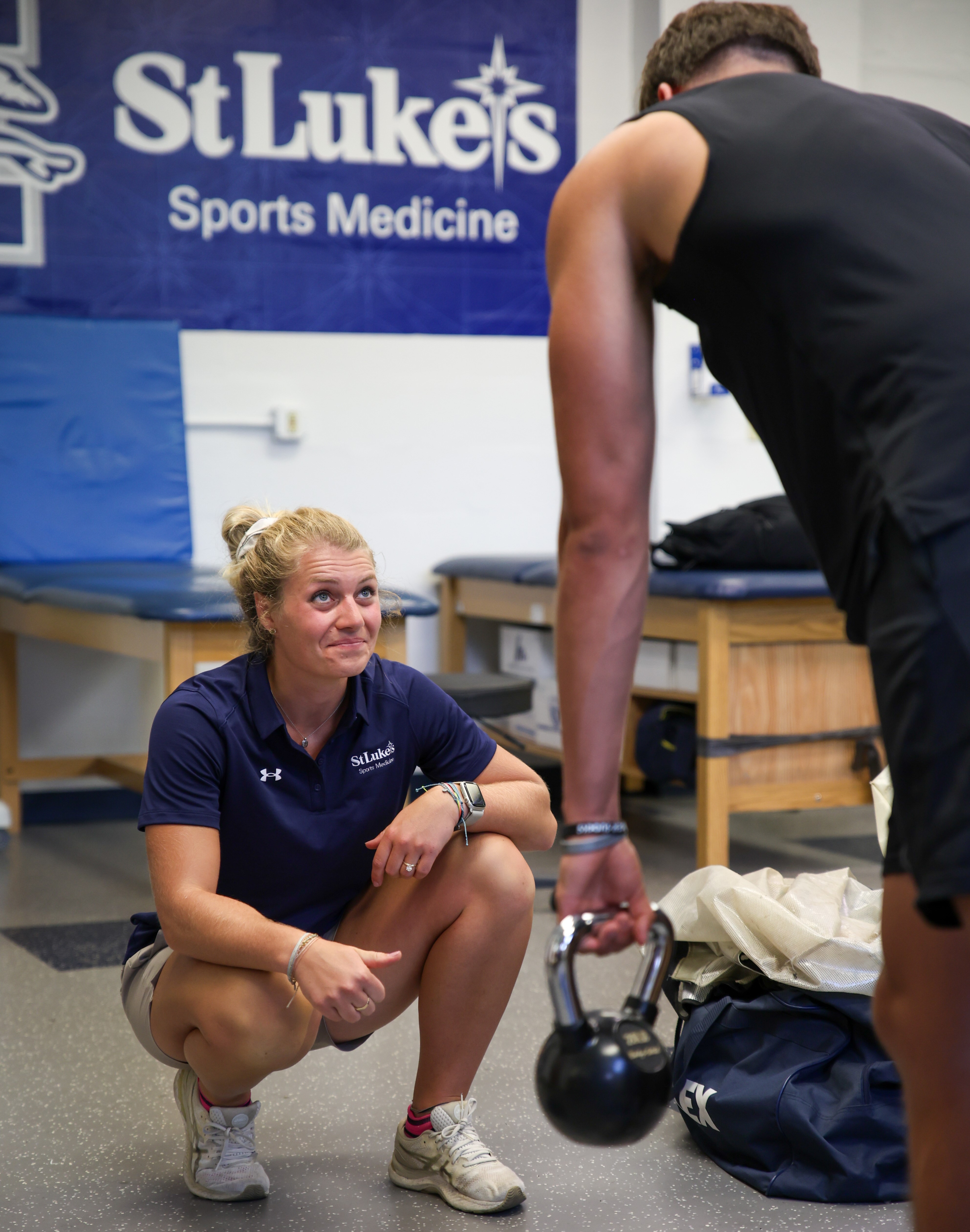Athletic Trainer Shortage? It Depends
August 27, 2024

St. Luke’s Athletic Trainer (AT) Briana Gratz, MS, LAT, ATC, can’t wait to get on the sidelines of Moravian University ’s men’s soccer or women’s basketball teams this season for the first time. She’s eager to provide medical care if a player gets hurt, triage injuries, keep the players healthy and prepared for competition, and, of course, heartily cheer them on. It will be the first time in her five-year AT career that Gratz is actually feeling fulfilled in her cherished profession, and she’s planning to remain with St. Luke’s for a long time.
The 28-year-old, Master’s-prepared AT left her previous position at Ohio State University, exhausted from overwork, underpaid and treated “like a number.” She wanted out was grateful to be hired for what she calls her “dream job” at St. Luke’s in its Sports Medicine Relationships department.
St. Lukes employs over 150 athletic trainers who are contracted to 61 school districts, seven college and universities, two professional organizations, and many youth and community sports organizations in the St. Luke’s service area. In addition to the athletic training services, St. Luke’s Sports Medicine also employs sports performance coaches who are allocated to schools as well as some network operated sports facilities.
The program was developed and now is managed by a group of athletic trainers, accumulating over 150 years of collective experience. The program’s focus is on delivering industry best practice standards of care to its community, programs, and partners while providing its staff a safe culture that promotes professional development and vocational fulfillment.
The exodus of athletic trainers from collegiate sports is a growing and concerning trend around the country, according to Brian Wiese, St. Luke’s Program Manager for Professional, College & University programming. He cites a recent joint statement by the National Athletic Trainers’ Association and American College of Sports Medicine detailing how collegiate athletics is suffering from a “labor crisis,” which started during the post-pandemic “Great Resignation.” The paper based its claims on a survey it conducted of more than 1,120 collegiate ATs across the country, which found that “compensation, organizational culture, burnout and increased work responsibility were the significant themes that emerged.”
But Wiese, who has been with St. Luke’s since 2022 after spending 10-plus years in professional and Division 1 athletics, insists there’s really no shortage of athletic trainers. Instead, many of them have left the hard-driving, year-round grind in college sports programs, opting for more rewarding and more balanced positions in medical clinics, industrial settings, medical sales, the military, performing arts, and other job settings.
“The AT job in collegiate athletics today is vastly different than it was just 10 years ago, mostly due to continued increases in job duties and responsibilities. Fewer people these days are willing to take on the added responsibility when compensation or other factors linked to job satisfaction have not changed or even declined,” said Wiese, a 13-year veteran of the sports medicine profession. “And with more opportunities for employment for ATs, many are choosing those pathways.”
The National Athletic Trainers’ Association and American College of Sports Medicine statement recommends sports programs take positive actions to better hold onto and attract ATs, many measures, Wiese says, St. Luke’s already has implemented successfully.
“We do a really good job recruiting and retaining our AT workforce. Our compensation is generally above local, regional and national salary rates within the profession, based on years of experience. We encourage our athletic trainers to enjoy a work-life balance and treat them like professionals, not numbers. We recognize that they have families, friends, outside interests, and other responsibilities and priorities.”
Wiese continues, “The AT staffing levels we provide at our partner schools ensure the athletic trainers are able to handle the athletic program volume and needs without overloading or overwhelming our staff. Our athletic trainers are valued as health care providers, not just support staff. Additionally, we provide thorough onboarding and mentorship of all our athletic trainers, with a specific focus on our early professionals who are newly hired.”
As a result, St. Luke’s has a lower athletic trainer attrition rate than what generally is seen nationally. “We are proud to support our community and the regional sports programs, where our teams treat our athletes’ health as their top priority,” Wiese said.
Mitch Wasik, MS, LAT, ATC, St. Luke’s Head Athletic Trainer at Alvernia University, Reading, said he’s seen this attrition trend looming on the horizon for a decade or longer.
“Fewer colleges or universities are offering the master’s in athletic training, which has become the required education level in the specialty, and more ATs are leaving the collegiate sports setting in their 40’s than ever,” said Wasik, 57, who has 32 years’ experience in this profession.
He sees frequent social media posts trying to recruit athletic trainers.
“I also have many programs asking me if I know anybody who can fill AT positions,” he added. “Lots of places are having a hard time recruiting ATs.”
“I’m glad to be with St. Luke’s,” he added. “They’re treating their ATs right.”
Gratz, the newest AT at St. Luke’s, says she “loves it here.” She joined Wiese’s team in July and feels already it’s the fit she’s sought/dreamed of for years.
The pay is better than she’s ever earned, she can take time off for family events and weddings of friends, and most importantly, she says, “I feel like I matter here.” At other athletic trainer positions she’s held, “the job is your life. I got burned out, had no personal time and wasn’t paid fairly.” That changed greatly when she joined St. Luke’s, and she’s thrilled to be part of the team at Moravian.
“This job is too good to be true!”
Read More NewsLatest News

June 16, 2025


